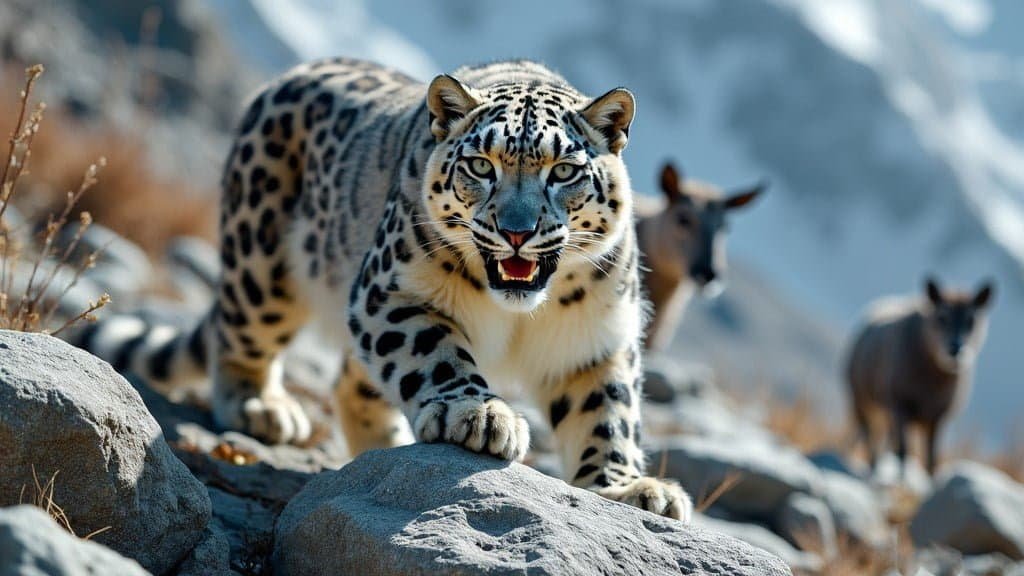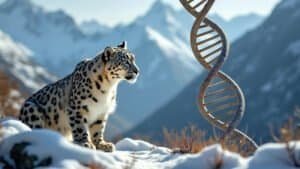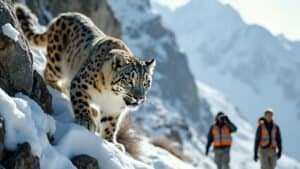Introduction
Snow leopards, iconic predators of the mountainous regions of Central and South Asia, rely heavily on specific prey species to survive. This article delves into the main prey species of snow leopards, such as blue sheep and ibex, and examines how these prey populations influence snow leopard numbers
We will explore how prey availability impacts snow leopard survival, the effects of human activities on prey species, and the adaptations snow leopards make in response to changes in their food sources. Finally, we’ll look at the crucial role conservation efforts play in maintaining a balance between predator and prey populations
Main Prey Species of Snow Leopards
Snow leopards, often referred to as “ghosts of the mountains,” are apex predators that inhabit the high-altitude regions of Central and South Asia, including parts of the Himalayas, Tibetan Plateau, and Altai Mountains
These elusive cats have evolved to thrive in some of the most rugged terrains on Earth, where their survival is intricately linked to the availability of specific prey species. Understanding the dietary habits of snow leopards is crucial for conserving these majestic animals, as their populations are directly influenced by the abundance and distribution of their prey
Primary Prey in Different Regions
Snow leopards primarily prey on large herbivores that share their mountainous habitat. The composition of their diet can vary significantly depending on the region. In the Himalayas and Tibetan Plateau, their primary prey includes blue sheep (bharal) and the Himalayan ibex
These species are well adapted to steep, rocky terrains and can constitute up to 60-70% of the snow leopard’s diet in these areas. The blue sheep, in particular, is a vital prey species; its population density directly correlates with snow leopard numbers
In the Altai Mountains and other parts of their range, snow leopards hunt Siberian ibex, argali (wild sheep), and sometimes even smaller mammals like marmots and hares, especially when larger prey is scarce
The availability of these prey species not only influences where snow leopards can live but also affects their reproductive success and cub survival rates. In regions where prey is abundant, snow leopards are more likely to raise successful litters
Conversely, in areas with low prey density, snow leopards may expand their territories, which can lead to increased energy expenditure and reduced chances of reproductive success
Importance of Blue Sheep and Ibex
The blue sheep (Pseudois nayaur) and the ibex (Capra sibirica) are two of the most important prey species for snow leopards. Blue sheep, with their large body size and herd behavior, provide substantial nutrition, allowing snow leopards to sustain themselves and their offspring through the harsh winter months
A single blue sheep kill can provide enough food for a snow leopard for several days. The close association between snow leopards and blue sheep is evident in the overlapping habitats and the synchronized population dynamics observed in several studies
For instance, a decline in blue sheep numbers due to disease or human activities often results in a corresponding decline in snow leopard populations, underscoring the importance of this prey species
Similarly, ibex, which are found in more rugged and higher-altitude regions, are another crucial prey species. The hunting of ibex requires significant energy expenditure due to their agility and the challenging terrain they inhabit
However, the high nutritional value of ibex meat makes them a preferred target, especially for adult snow leopards. The health of ibex populations is therefore closely monitored as an indicator of snow leopard health in several conservation areas
Lesser-Known Prey Species
While blue sheep and ibex are the most prominent prey, snow leopards are opportunistic hunters and their diet includes a variety of other species. Marmots, pika, and hares are common prey, especially in areas where larger ungulates are less abundant
These smaller mammals can become a significant part of the diet during the summer months when they are more accessible. Additionally, in some regions, snow leopards have been observed preying on domestic livestock, such as sheep and goats, which can lead to conflicts with local herders
The inclusion of smaller mammals and livestock in the snow leopard’s diet is often a response to the scarcity of their preferred prey. This dietary flexibility allows snow leopards to survive in diverse environments, but it also brings them into closer contact with humans, increasing the risk of retaliatory killings
Therefore, understanding the full range of prey species is essential for developing comprehensive conservation strategies that protect both snow leopards and their prey
Impact of Prey Availability on Snow Leopard Populations
The availability of prey is one of the most critical factors influencing snow leopard populations. As apex predators, snow leopards rely heavily on a consistent supply of large ungulates like blue sheep and ibex to meet their nutritional needs
However, fluctuations in prey populations, driven by both natural and human-induced factors, can have significant consequences for snow leopards, affecting their survival, reproductive success, and even their territorial behavior
Prey Density and Snow Leopard Survival
Prey density plays a fundamental role in determining the health and stability of snow leopard populations. Scientific research has shown that areas with higher prey densities tend to support larger and more stable snow leopard populations
For instance, studies conducted in the Spiti Valley of India found a direct correlation between the abundance of blue sheep and the density of snow leopards in the region. In areas where prey is abundant, snow leopards are not only more likely to survive but also have higher reproductive success, with more cubs reaching maturity
Conversely, in regions where prey densities are low, snow leopards may struggle to find enough food, leading to increased mortality rates, reduced breeding success, and greater competition among individuals
A study published in the journal Biological Conservation highlighted that in parts of Mongolia, where prey populations have declined due to overgrazing by livestock, snow leopard numbers have also decreased significantly. This decline is often exacerbated by the expansion of human activities, which further reduces the availability of natural prey
How Scarcity Affects Territory Size and Behavior
When prey is scarce, snow leopards are forced to adapt by expanding their territories in search of food. This expansion often leads to overlapping territories, which can increase the likelihood of conflicts between individuals, particularly males
Larger territories require snow leopards to travel greater distances, which increases their energy expenditure and reduces the time available for hunting and resting. In some cases, snow leopards may even migrate to lower altitudes or areas closer to human settlements, where they are more likely to come into contact with livestock, leading to potential human-wildlife conflicts
Behavioral adaptations to prey scarcity also include changes in hunting strategies. Snow leopards may shift from ambush hunting, which requires waiting for prey to come within striking distance, to more active hunting strategies that involve pursuing prey over longer distances
However, this shift can be energetically costly, and may not always be successful, especially in rugged terrain. Additionally, in regions where prey scarcity is a persistent issue, snow leopards may increase their reliance on smaller mammals or even carrion, though these alternatives do not provide the same nutritional benefits as large ungulates
Regional Variations in Prey Availability
The availability of prey species varies significantly across the snow leopard’s range, leading to regional differences in diet and behavior. In some areas, such as the Pamir Mountains in Tajikistan, ibex and Marco Polo sheep (a subspecies of argali) are the dominant prey species
In contrast, in the trans-Himalayan regions of India and Nepal, blue sheep are the primary prey. These regional differences are influenced by a variety of factors, including climate, altitude, vegetation, and human activities
In regions where prey populations are naturally low or have been depleted due to human impacts, snow leopard populations tend to be smaller and more fragmented
For example, in the Gobi Desert, where prey is scarce, snow leopards have been observed to have larger home ranges compared to those in prey-rich areas like the Tien Shan Mountains. This suggests that prey availability is a key determinant of snow leopard population density and distribution
Moreover, in regions where prey species are affected by diseases, such as the outbreak of sarcoptic mange among blue sheep in the Indian Himalayas, snow leopard populations can suffer significant declines
Conservation efforts in these areas often focus on managing prey populations through habitat protection, anti-poaching measures, and sometimes even reintroduction programs to ensure a stable food supply for snow leopards
Human Impact on Snow Leopard Prey
Human activities have a profound impact on the prey species of snow leopards, which in turn affects the populations and behaviors of these elusive predators
The primary human-driven factors influencing snow leopard prey include overhunting, habitat loss, and competition with livestock. Understanding these impacts is essential for developing effective conservation strategies aimed at protecting both snow leopards and their prey
Overhunting and Its Effects on Prey Populations
One of the most significant threats to snow leopard prey species is overhunting by humans
In many parts of Central and South Asia, local communities hunt wild ungulates like blue sheep, ibex, and argali for food, traditional medicine, and trophy hunting. This hunting pressure can severely deplete prey populations, leaving snow leopards with fewer food resources
A study conducted in Kyrgyzstan, published in Oryx, highlighted the decline in ibex and argali populations due to illegal hunting and weak enforcement of hunting regulations
The researchers found that in areas with high levels of poaching, snow leopard sightings were significantly reduced, indicating a direct link between overhunting of prey and the decline in snow leopard populations
This relationship underscores the need for stronger legal protections for prey species, as well as community-based conservation programs that provide alternative livelihoods to reduce dependence on hunting
Habitat Loss and Prey Accessibility
Habitat loss is another major factor affecting the availability of snow leopard prey. As human populations expand, more land is converted for agriculture, infrastructure development, and mining
This encroachment reduces the available habitat for wild ungulates, forcing them into smaller, more fragmented areas. As a result, prey populations become isolated, reducing genetic diversity and making them more vulnerable to diseases and environmental changes
For instance, in the Himalayas, the construction of roads and hydroelectric projects has led to the fragmentation of habitats crucial for blue sheep and ibex. These developments not only limit the movement and distribution of prey species but also make them more accessible to human hunters, further exacerbating the decline in prey populations
Snow leopards, which rely on these prey species, are then forced to either expand their territories or prey on domestic livestock, increasing the likelihood of conflict with humans
Moreover, habitat degradation caused by overgrazing, deforestation, and climate change further reduces the quality and quantity of forage available to prey species
A study published in Biological Conservation reported that overgrazing by livestock in parts of Mongolia and India has led to a significant reduction in the vegetation cover, which in turn has decreased the carrying capacity for wild ungulates like blue sheep and ibex
As the natural prey base diminishes, snow leopards face greater challenges in securing adequate food, which can lead to malnutrition, lower reproductive success, and higher mortality rates
Conservation Efforts to Protect Prey Species
To mitigate the impact of human activities on snow leopard prey, several conservation initiatives have been implemented across the snow leopard’s range. These efforts often focus on protecting and restoring habitats, enforcing hunting regulations, and working with local communities to reduce human-wildlife conflicts
Protected areas, such as national parks and wildlife reserves, play a crucial role in conserving prey species by providing safe habitats where hunting is strictly regulated or prohibited. For example, in the Hemis National Park in India, strict anti-poaching measures and habitat restoration projects have helped stabilize populations of blue sheep and ibex, which has also benefited the local snow leopard population
Additionally, transboundary conservation efforts, such as the establishment of the Sacred Himalayan Landscape across Nepal, India, and Bhutan, aim to create large, connected habitats that support both prey and predator species
Community-based conservation programs are also vital in addressing the root causes of prey depletion
Initiatives like the Snow Leopard Trust’s Livestock Insurance Program and Predator-Proof Corrals provide local herders with financial compensation and protective measures to prevent snow leopard attacks on livestock. By reducing the economic losses caused by snow leopard predation, these programs help alleviate the pressure on wild prey species by decreasing the retaliatory killings of snow leopards and reducing the reliance on hunting
Furthermore, education and awareness campaigns are essential in promoting the conservation of prey species
These campaigns often involve local communities, educating them about the ecological importance of wild ungulates and the benefits of maintaining a healthy ecosystem. Through these combined efforts, it is possible to create a more sustainable coexistence between humans, snow leopards, and their prey
Adaptations of Snow Leopards to Changing Prey Populations
Snow leopards, known for their adaptability to harsh environments, also exhibit remarkable flexibility in their diet and behavior in response to fluctuations in prey populations
These adaptations are crucial for their survival in the dynamic and often unforgiving habitats they occupy. As prey availability changes due to natural cycles, human impact, or environmental changes, snow leopards adjust their hunting strategies, territorial behavior, and even their reproductive patterns to cope with these challenges
Behavioral Adaptations to Prey Scarcity
When prey becomes scarce, snow leopards demonstrate significant behavioral changes to optimize their chances of survival. One of the primary adaptations is the expansion of their home range. Snow leopards typically maintain large territories, but when prey is abundant, they can afford to stay within smaller, more manageable areas
However, during periods of prey scarcity, they are known to expand their territories considerably, sometimes covering areas up to 500 square miles. This expansion is necessary to find sufficient food but comes at the cost of increased energy expenditure and potential conflicts with other snow leopards, especially in regions where territories overlap
Another behavioral adaptation is a shift in hunting strategies. Snow leopards usually rely on ambush techniques, using the rugged terrain to their advantage to surprise their prey
However, in areas where prey is less abundant or more difficult to capture, snow leopards may engage in more active hunting, stalking their prey over longer distances
They may also increase their activity during dawn and dusk when prey animals are more likely to be moving, rather than sticking to a strictly nocturnal schedule. These adjustments are energy-intensive but necessary for securing food in challenging conditions
Shifts in Diet and Hunting Techniques
In response to changes in prey populations, snow leopards also exhibit dietary flexibility. While their preferred prey includes large ungulates such as blue sheep and ibex, they are opportunistic hunters and will adjust their diet based on availability
In times of prey scarcity, snow leopards may turn to smaller mammals like marmots, pika, and hares, which are more abundant but provide less nutritional value. This shift in diet is particularly common in the summer months when these smaller mammals are more active and accessible
Additionally, snow leopards have been observed preying on birds, rodents, and even carrion when other food sources are not available. In some regions, especially where human encroachment is significant, snow leopards have increasingly turned to domestic livestock as a food source
This shift not only highlights their adaptability but also underscores the growing challenge of human-wildlife conflict. Livestock predation often leads to retaliatory killings by local herders, posing a significant threat to snow leopard populations
Moreover, snow leopards may alter their hunting techniques to cope with the varying availability of prey. In regions where ibex and other agile prey are predominant, snow leopards may develop specialized hunting skills to navigate steep cliffs and rocky outcrops effectively
In contrast, in areas where prey is more scarce or smaller, they may employ more strategic approaches, using cover and stealth to get closer to their prey before launching an attack. These variations in hunting behavior are critical for their survival across diverse environments and changing prey dynamics
The Role of Prey in Snow Leopard Reproductive Success
The availability of prey has a direct impact on the reproductive success of snow leopards. During times of prey abundance, snow leopards are more likely to have successful pregnancies and rear multiple cubs
Adequate food supplies ensure that female snow leopards have the necessary energy reserves to carry and nurse their young, and that cubs can grow and develop properly. In contrast, when prey is scarce, the physical condition of females can deteriorate, leading to lower birth rates, higher cub mortality, and in some cases, failed pregnancies
Research conducted in Mongolia’s Tost Mountains, published in Animal Conservation, indicates that snow leopard cub survival rates are closely linked to the abundance of their primary prey, such as ibex and argali
In years when prey populations were low, fewer cubs survived to adulthood, and those that did were often smaller and weaker. This finding underscores the importance of stable prey populations for the long-term viability of snow leopard populations
Furthermore, the timing of snow leopard births is often synchronized with periods of peak prey availability. In many parts of their range, snow leopard cubs are born in late spring or early summer when prey animals like blue sheep and ibex give birth, providing an abundance of young, vulnerable prey
This timing ensures that the demands of lactation and feeding growing cubs coincide with the easiest hunting periods, maximizing the chances of cub survival
Snow leopards’ ability to adapt their reproductive strategies to prey availability is a key factor in their survival, but it also highlights the delicate balance required to maintain healthy populations. Conservation efforts that focus on protecting and enhancing prey populations are therefore essential for ensuring that snow leopards can continue to thrive in the wild
Conclusion
The survival of snow leopards is intricately linked to the availability and health of their prey species. Key prey such as blue sheep and ibex not only sustain snow leopard populations but also influence their behavior, territory size, and reproductive success
Fluctuations in prey populations, whether due to natural factors or human activities like overhunting and habitat destruction, have profound impacts on snow leopards, often forcing them to adapt in ways that can increase their vulnerability
Conservation efforts that focus on protecting these prey species and their habitats are crucial for maintaining stable snow leopard populations. By addressing both the needs of the predator and its prey, we can help ensure the continued existence of these magnificent animals in the wild







